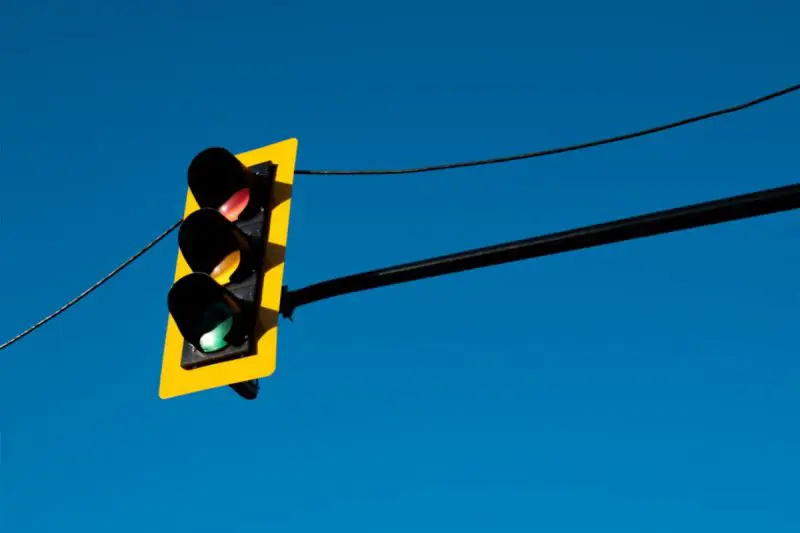When it comes to traffic lights, you might think that the size of the lenses are pretty standard.
But what about the height, width, and depth? How much space is needed?
The answer depends on where you live. In some places, like California, there are no specific regulations regarding traffic signals.
However, in many states, including New York, Michigan, and Washington, D.C., there are laws governing how large traffic signals must be. For example:
In New York, most traffic signals have to be at least 5 feet high, 3 feet wide, and 4 feet deep.
Michigan requires that traffic signals be at least 10 feet high, 7 feet wide, and 5 feet deep.
Washington, D.C., has similar requirements, requiring traffic signals to be at least 11 feet high, 8 feet wide, and 5.5 feet deep.
In addition to those rules, the Federal Highway Administration recommends that traffic signals be at most 14 feet high, 9 feet wide, and 6 feet deep.
What Variations Are There?
The size of a traffic light depends on many factors, including the number of cars that are traveling along a road, the speed limit, and the distance between intersections.
If you want to know how big a red light looks, here’s what affects it.
Location
As we know, traffic lights are designed to help people move safely through intersections.
They’re also used to communicate information about road conditions to motorists. In many places, the most common type of traffic signal is known as the four-quadrant signal.
This consists of a pair of red and green lights located above a crosswalk. Drivers know exactly what to do when approaching such a signal.
But there’s another type of signal found in some cities: the 12-inch signal. These signals consist of a single large red light mounted on a pole.
Drivers must approach slowly because they don’t know how long the light will remain red. And once the light turns green, it stays green for quite a while.
These signals are typically installed in more heavily trafficked areas where drivers tend to be impatient.
So why do some places use the smaller lights and others the larger ones?
According to the American Association of State Highway Transportation Officials, the answer lies in the number of vehicles that travel along certain roads.
In general, states with fewer cars per capita tend to use larger traffic signals. For example, California uses the 12-inch light, while New Jersey prefers the eight-inch version.
However, this doesn’t explain why New York City favors the 12-inch light and Los Angeles the eight-inch one.
After all, both cities have similar populations making it hard to believe that the difference is purely based on traffic volumes.
So what gives? To figure out the real reason behind the different sizes of traffic lights, we turned to data visualization experts at Visual Capitalist.
Using satellite images of each state, they identified the density of buildings near the intersection of major highways.
Then, they compared the average height of those structures across the entire US.
The results showed that highly dense urban areas like New York and LA favor the larger traffic lights.
On the other hand, less crowded states like North Dakota and Montana prefer the smaller ones.
Laws
In most states, there are certain laws that apply to traffic signals.
They include things like what type of light to use, where to place them, the maximum number of lights allowed per intersection, etc.
If you don’t follow these rules, you could face fines and/or jail time.
For example, in New York City, there are traffic lights that display red, yellow, green, and flashing amber lights.
Each color indicates a different speed limit. Red means slow down; yellow means moderate speed; green means go ahead; and flashing amber means stop.
The law says that the city uses four types of lights: three-phase, single-phase, double-phase, and quadrant.

A three-phase light consists of three bulbs arranged in a triangle shape. Single-phase lights are similar to those found in many homes today.
Double-phase lights consist of two bulbs arranged in a square shape. Quadrant lights are used in intersections with multiple lanes.
If the rules stipulate using 12-inch lens traffic signals there is a good reason and this rule must be followed to stay compliant.
Traffic Light Components
Controller
The controller is the heart of the traffic signal system.
It controls everything inside the box, including the timing of the lights, the movement of the vehicles, and even the emergency signals.
In addition to controlling the entire traffic light system, the controller must also manage many other functions, such as the detection of accidents, the monitoring of the power supply, and the management of the communications network.
In addition to regulating traffic flow, traffic signals provide information about road conditions such as speed limits, stop signs, crosswalks, etc.
This allows drivers to make better decisions regarding driving habits and helps reduce accidents.
A traffic signal typically consists of five main components:
1. Target Board — The target board displays the current phase of the traffic light cycle.
2. Lamp — The lamp indicates whether the lights are red, yellow, green, or flashing.
3. Pedestrian Detector — The pedestrian detector detects pedestrians crossing the street.
4. Pole — The pole holds up the traffic signal.
5. Camera — The camera captures images of vehicles to determine how fast they are traveling.
Installation
Traffic signals are installed in many cities around the world.
They are usually controlled remotely, meaning that the engineer doesn’t always need to travel to the site where the lights are located once the installation is complete.
Installation requires careful planning and the entire process takes several days.
In addition to the physical work involved, there are several steps during the installation process that require special attention.
The first step involves designing the layout of the circuit. Engineers use CAD software to design the wiring scheme.
The second stage is the actual construction of the circuit. During this phase, the engineers install the cables and connect them to each other.
The third stage involves testing the connection points.
Here, the engineer checks whether the connections are secure enough to withstand the pressure of the traffic flow.
Finally, the fourth stage includes the installation of the controllers and the signal supports.
These parts are mounted in the road surface and passed through the base. Once everything is ready, the final tests begin.
Conclusion
Traffic signals play an important role in keeping our roads safe. They help us avoid collisions by giving us advance warnings of dangerous situations.
They also allow for smoother traffic flow by allowing cars to move at different speeds.
However, traffic signals can cause problems if not properly maintained. For example, poorly designed signals may lead to increased traffic jams.
It’s also crucial they are the correct size for the traffic conditions.
If you made it this far, you may also be interested in knowing how long and wide cars on the road are these days.
- What Size is Regular Printer Paper? Quick Guide for Paper Dimensions - June 18, 2023
- What Size is My Monitor: A Comprehensive Guide - June 18, 2023
- How Big is Italy Compared to the US? A Concise Comparison - June 16, 2023

